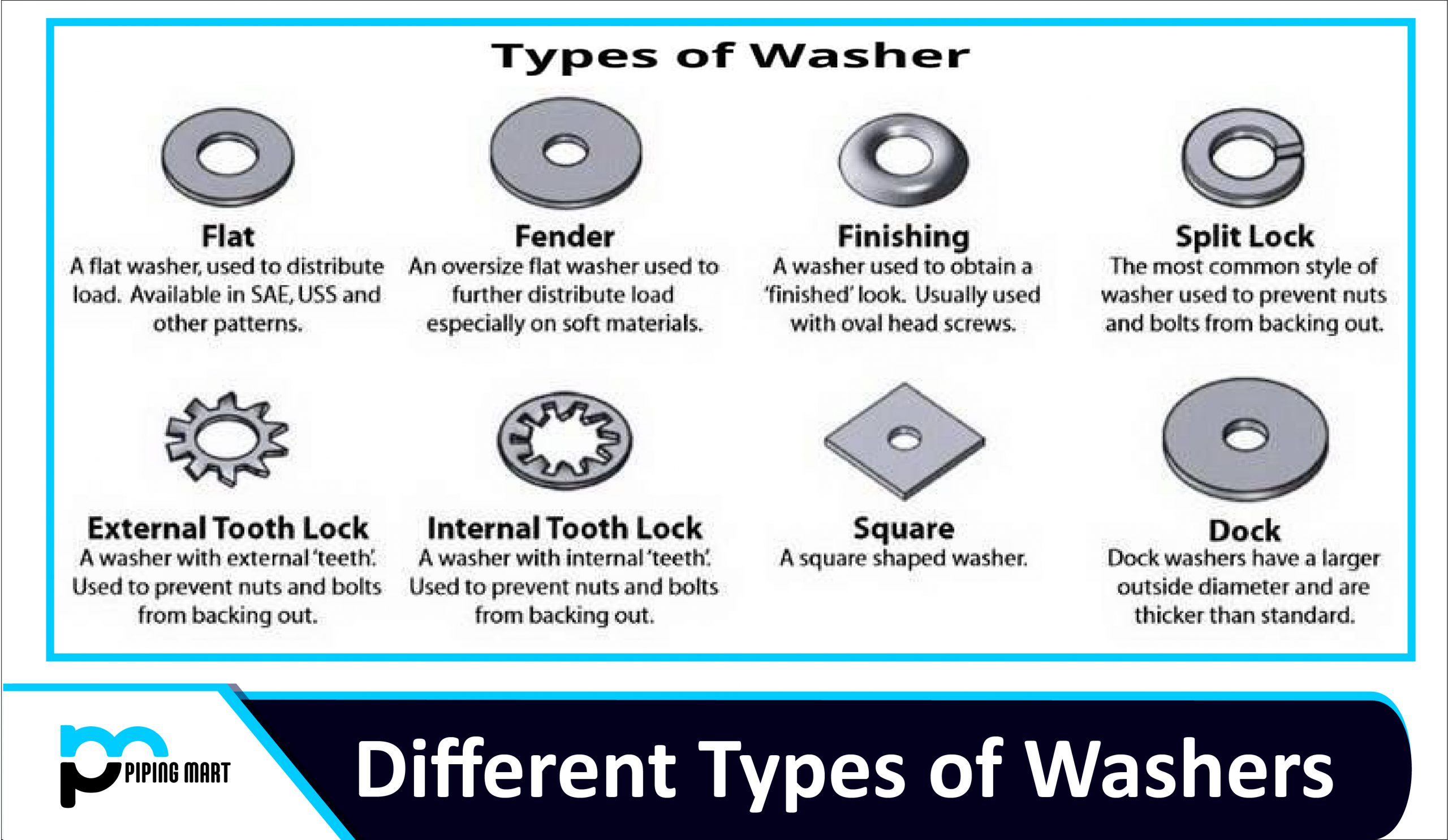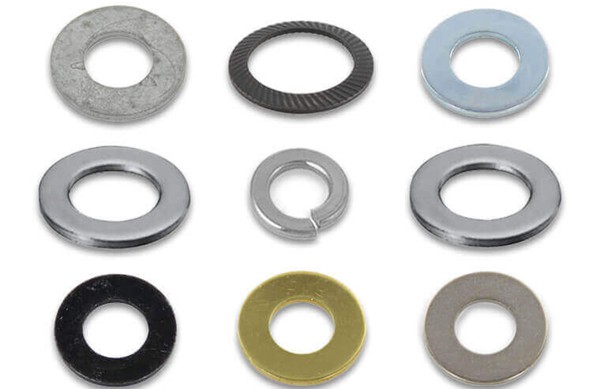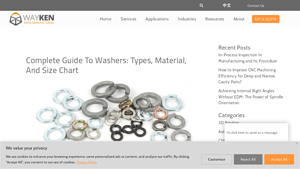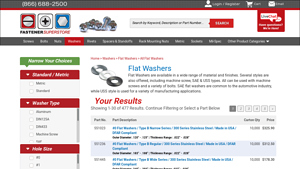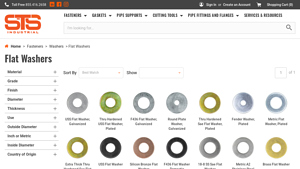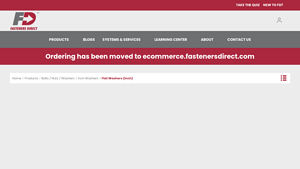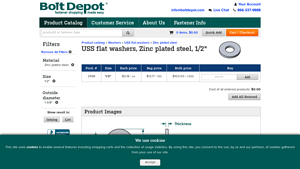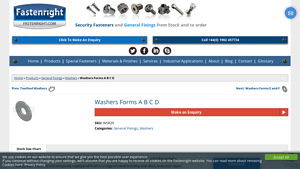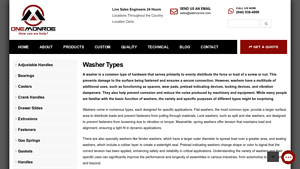Types Of Flat Washers Guide: Type, Cost, Top List…
Introduction: Navigating the Global Market for types of flat washers
In today’s global market, sourcing the right types of flat washers can pose significant challenges for B2B buyers, particularly those operating in diverse industrial sectors across Africa, South America, the Middle East, and Europe. With a myriad of options available—from plain and finishing washers to specialized variants like fender and shoulder washers—making informed decisions is crucial for ensuring optimal performance and reliability in fastening applications. This comprehensive guide delves into the various types of flat washers, their specific applications, and the materials that best suit different operational environments.
As you navigate through the complexities of washer selection, this guide aims to equip you with the knowledge needed to evaluate suppliers effectively, understand cost implications, and recognize the importance of quality standards. Each section is designed to enhance your purchasing process, addressing common concerns such as load distribution, corrosion resistance, and vibration absorption—key factors that influence the longevity and effectiveness of your assembly systems.
By empowering international B2B buyers with actionable insights and detailed information, this guide is your essential resource for optimizing your sourcing strategies. Whether you are in the automotive, electronics, or manufacturing industries, understanding the nuances of flat washer types will enable you to make decisions that not only meet your technical requirements but also align with your business goals.
Understanding types of flat washers Types and Variations
| Type Name | Key Distinguishing Features | Primary B2B Applications | Brief Pros & Cons for Buyers |
|---|---|---|---|
| Flat Washer | Circular, flat disc with a central hole; distributes load evenly | Construction, automotive, electronics | Pros: Cost-effective, versatile; Cons: Limited vibration absorption. |
| Fender Washer | Larger diameter with a smaller hole; spreads load over a wide area | Sheet metal work, plumbing, automotive fenders | Pros: Excellent load distribution; Cons: Bulkier design may limit use in tight spaces. |
| Countersunk Washer | Sunken top surface; designed to create a flush finish with screws | Furniture assembly, cabinetry | Pros: Aesthetic finish; Cons: Limited to specific screw types. |
| Shoulder Washer | Features a shoulder for insulation; made from non-conductive materials | Electrical components, wiring applications | Pros: Provides insulation; Cons: More expensive than standard washers. |
| Torque Washer | Square holes to prevent rotation; used primarily in woodworking | Woodworking, furniture manufacturing | Pros: Prevents bolt rotation; Cons: Limited application scope. |
What Are the Characteristics of Flat Washers?
Flat washers are essential components that provide load distribution for fasteners. Their circular shape and central hole allow them to be placed easily under nuts and bolts, preventing damage to the material being fastened. Suitable for various applications, flat washers are particularly effective in construction, automotive, and electronic industries. When purchasing flat washers, buyers should consider factors like material (steel, stainless steel, or plastic), size, and the specific load requirements of their application.
Why Choose Fender Washers for Your Projects?
Fender washers are distinguished by their larger diameter, which allows them to spread the load over a wider area. This feature makes them particularly useful in sheet metal work, plumbing, and automotive fender applications. They are designed to prevent damage to softer materials by distributing the force from fasteners evenly. Buyers should evaluate the thickness and diameter of fender washers to ensure compatibility with their specific projects, as well as consider the materials used for corrosion resistance.
How Do Countersunk Washers Enhance Aesthetic Appeal?
Countersunk washers are designed with a sunken top surface that allows screws to sit flush with the material surface, providing a clean and professional finish. They are commonly used in furniture assembly and cabinetry, where appearance matters. While they enhance aesthetics, buyers must ensure that their screws are compatible with countersunk washers to achieve the desired effect. The limited application scope may be a consideration for those seeking versatility.
What Are the Advantages of Using Shoulder Washers?
Shoulder washers are unique in that they feature a shoulder, which provides insulation and spacing for electrical components and wiring applications. Made from non-conductive materials, they are crucial in preventing electrical shorts. While they are more expensive than standard flat washers, their insulating properties can save costs related to electrical failures. Buyers should assess the specific insulation requirements and ensure that the shoulder washer fits their application’s dimensions.
When Should You Consider Torque Washers?
Torque washers are specifically designed with square holes that prevent bolts from rotating during tightening, making them ideal for woodworking and furniture manufacturing. Their unique design ensures that the fastener remains secure, even in applications where vibration may be a concern. However, their use is generally limited to specific applications, so buyers should evaluate whether the torque washer’s benefits align with their project needs.
Key Industrial Applications of types of flat washers
| Industry/Sector | Specific Application of types of flat washers | Value/Benefit for the Business | Key Sourcing Considerations for this Application |
|---|---|---|---|
| Automotive | Use of flat washers in vehicle assembly and maintenance. | Enhances vehicle durability and performance by distributing loads evenly, preventing material deformation. | Ensure compliance with industry standards and select corrosion-resistant materials for longevity. |
| Construction | Application of fender washers in structural frameworks. | Provides stability and strength to connections, crucial for safety in building structures. | Sourcing should focus on load-bearing capabilities and environmental resistance. |
| Electronics | Shoulder washers used as insulators in electronic devices. | Protects sensitive components from electrical interference and ensures reliable operation. | Materials must meet electrical insulation standards and be compatible with the device’s design. |
| Manufacturing | Use of plain washers in machinery assembly. | Reduces friction and heat, enhancing the lifespan of machinery parts. | Consider the specific size and load requirements for optimal performance. |
| Aerospace | Lock washers in aircraft assembly to secure fasteners. | Prevents loosening due to vibrations, ensuring safety and reliability in flight operations. | Sourcing should prioritize lightweight materials with high strength-to-weight ratios. |
How Are Flat Washers Used in the Automotive Industry?
In the automotive sector, flat washers are integral to both assembly and maintenance processes. They are used to distribute the load of fasteners, thereby preventing deformation of materials during the tightening process. This application is critical in enhancing vehicle durability and performance, particularly under varying operational stresses. When sourcing, businesses must ensure that the washers are made from corrosion-resistant materials to withstand the harsh environments often encountered in automotive applications.
What Role Do Flat Washers Play in Construction?
Fender washers are commonly employed in construction, particularly in structural frameworks where they provide stability to connections. Their larger surface area allows for even load distribution, which is essential for maintaining the integrity and safety of building structures. For international buyers, it is vital to source washers that meet local building codes and standards, as well as those that are resistant to environmental factors such as moisture and corrosion, ensuring long-lasting performance.
How Are Flat Washers Essential in the Electronics Sector?
In the electronics industry, shoulder washers serve as insulators for fasteners and wires, protecting sensitive components from electrical interference. This application is particularly important in devices where reliable operation is critical. Buyers should prioritize sourcing washers made from non-conductive materials that comply with electrical safety standards, ensuring compatibility with the overall device design and functionality.
Why Are Flat Washers Important in Manufacturing?
Flat washers are widely used in manufacturing machinery assembly, where they help reduce friction and heat generated during the operation of moving parts. This function extends the lifespan of machinery components, leading to reduced maintenance costs and increased productivity. When sourcing washers, businesses need to consider the specific size and load requirements to ensure optimal performance in their machinery applications.
How Do Lock Washers Contribute to Aerospace Safety?
In the aerospace industry, lock washers are vital for securing fasteners in aircraft assembly. Their design prevents loosening due to vibrations, which is critical for safety during flight operations. For businesses in this sector, sourcing lightweight yet strong materials is essential to maintain the performance and safety standards required in aerospace applications. Compliance with industry regulations is also a key consideration when selecting the appropriate lock washers.
3 Common User Pain Points for ‘types of flat washers’ & Their Solutions
Scenario 1: Ensuring Load Distribution to Prevent Material Damage
The Problem: B2B buyers often face issues with uneven load distribution when fastening components, leading to material deformation or failure. This is especially problematic in industries such as construction and manufacturing, where components are often made from softer materials that can crack or warp under pressure. Without proper load distribution, the integrity of the assembly is compromised, leading to costly repairs and project delays.
The Solution: To effectively address this challenge, buyers should prioritize the selection of flat washers specifically designed for load distribution. When sourcing flat washers, consider the material and thickness, as these factors significantly impact their load-bearing capacity. Opt for larger diameter flat washers to spread the load more evenly across the surface. Additionally, ensure that the washer is made from a suitable material that can withstand the operational environment, such as stainless steel for corrosion resistance or carbon steel for strength. Implementing these best practices will not only enhance the lifespan of the components but also reduce the risk of costly failures.
Scenario 2: Mitigating Vibration-Induced Fastener Loosening
The Problem: In industries like automotive and aerospace, fasteners are subject to high levels of vibration during operation. This can lead to loosening of bolts and nuts over time, risking structural integrity and safety. B2B buyers often struggle to find effective solutions to prevent this loosening, which can result in equipment failure and increased maintenance costs.
The Solution: The use of specialized flat washers, such as lock washers or spring washers, can be instrumental in combating vibration-induced loosening. When selecting washers, buyers should look for those that provide a locking mechanism, such as external tooth lock washers, which grip the surface of the nut and bolt to prevent rotation. Additionally, employing spring washers can help absorb vibrations and maintain tension in the fastener connection. It’s crucial to ensure that these washers are compatible with the specific fastener sizes and materials in use. By integrating these washers into fastening systems, companies can significantly enhance the reliability and longevity of their assemblies.
Scenario 3: Addressing Corrosion Concerns in Harsh Environments
The Problem: Many B2B buyers operate in environments where fasteners are exposed to moisture, chemicals, or extreme temperatures, leading to corrosion that compromises the effectiveness of washers and fasteners. This is particularly relevant in industries such as oil and gas, marine, and food processing, where the cost of corrosion-related failures can be substantial.
The Solution: To combat corrosion issues, buyers should invest in flat washers made from corrosion-resistant materials, such as stainless steel or specialized coatings like zinc plating. When sourcing washers, it’s essential to evaluate the environmental conditions they will be subjected to and select materials that offer the best protection against corrosion. Additionally, implementing a proactive maintenance program that includes regular inspections of fastener assemblies can help identify early signs of corrosion, allowing for timely replacements before failures occur. Buyers should also consider using sealing washers in applications where liquid ingress is a concern, as these can provide an additional barrier against environmental factors. By taking these steps, companies can prolong the lifespan of their fasteners and reduce maintenance costs significantly.
Strategic Material Selection Guide for types of flat washers
What Are the Key Properties of Common Materials Used for Flat Washers?
When selecting flat washers for specific applications, the material choice is critical. Different materials offer distinct properties that can significantly impact performance, durability, and compatibility with various environments. Below, we analyze four common materials used for flat washers: carbon steel, stainless steel, brass, and plastic.
How Do Carbon Steel Flat Washers Perform in Various Applications?
Carbon steel is a prevalent choice for flat washers due to its strength and cost-effectiveness. It typically has a high tensile strength, making it suitable for applications requiring robust load distribution. However, carbon steel is prone to corrosion, especially in moist or chemically aggressive environments.
Pros: Carbon steel washers are durable and inexpensive, making them ideal for high-volume applications. They perform well under moderate temperature and pressure conditions.
Cons: The susceptibility to rust and corrosion limits their use in outdoor or humid applications unless they are coated or treated.
Impact on Application: Carbon steel washers are best suited for general-purpose applications in dry environments. They may not be ideal for use in marine or chemical processing industries without additional protective coatings.
Considerations for International Buyers: Buyers should ensure compliance with relevant standards, such as ASTM or ISO, especially when exporting to regions with strict quality regulations.
What Advantages Do Stainless Steel Flat Washers Offer?
Stainless steel flat washers are known for their excellent corrosion resistance and durability. They are suitable for high-temperature applications and environments where exposure to moisture or chemicals is a concern.
Pros: The primary advantage of stainless steel is its resistance to rust and corrosion, which enhances the longevity of the fastened joint. They can withstand a wide range of temperatures and pressures.
Cons: Stainless steel washers are generally more expensive than carbon steel options. Their manufacturing process can also be more complex, leading to higher costs.
Impact on Application: Ideal for applications in the food and beverage industry, marine environments, and chemical processing, stainless steel washers maintain integrity under harsh conditions.
Considerations for International Buyers: Compliance with standards like DIN or JIS is crucial, especially in Europe and Asia. Buyers should also consider the specific grades of stainless steel (e.g., 304, 316) based on their application requirements.
How Does Brass Compare as a Material for Flat Washers?
Brass flat washers are often used in electrical applications due to their excellent conductivity and resistance to corrosion. They provide good mechanical properties and are aesthetically pleasing.
Pros: Brass washers are non-magnetic and resistant to tarnishing, making them suitable for electrical applications. They also offer good resistance to corrosion in non-acidic environments.
Cons: Brass is softer than steel, which may lead to deformation under heavy loads. Additionally, it can be more expensive than carbon steel.
Impact on Application: Brass washers are commonly used in plumbing, electrical, and decorative applications where aesthetics matter.
Considerations for International Buyers: Buyers should be aware of any restrictions on brass materials due to environmental regulations in certain regions, particularly in Europe.
What Role Do Plastic Flat Washers Play in Various Industries?
Plastic flat washers, made from materials like nylon or PVC, are lightweight and resistant to corrosion and chemicals. They are often used in applications where electrical insulation is required.
Pros: Plastic washers are non-conductive, lightweight, and resistant to various chemicals, making them suitable for a wide range of applications.
Cons: They may not withstand high temperatures or heavy loads as effectively as metal washers. Their mechanical strength is generally lower.
Impact on Application: Ideal for electronic devices, automotive applications, and environments where moisture is a concern, plastic washers can prevent corrosion and electrical conductivity.
Considerations for International Buyers: Ensure compliance with industry-specific standards, especially in electronics and automotive sectors. Buyers should also consider the temperature and chemical compatibility of the specific plastic used.
Summary Table of Material Selection for Flat Washers
| Material | Typical Use Case for types of flat washers | Key Advantage | Key Disadvantage/Limitation | Relative Cost (Low/Med/High) |
|---|---|---|---|---|
| Carbon Steel | General-purpose applications | Durable and cost-effective | Prone to corrosion | Low |
| Stainless Steel | Food, marine, and chemical industries | Excellent corrosion resistance | Higher cost and manufacturing complexity | High |
| Brass | Electrical and plumbing applications | Good conductivity and aesthetics | Softer material, prone to deformation | Medium |
| Plastic | Electronics and automotive applications | Lightweight and corrosion-resistant | Lower mechanical strength | Medium |
This guide provides a comprehensive overview of the strategic material selection for flat washers, allowing international B2B buyers to make informed decisions based on their specific application needs and regional compliance requirements.
In-depth Look: Manufacturing Processes and Quality Assurance for types of flat washers
What Are the Main Stages in Manufacturing Flat Washers?
The manufacturing process of flat washers is a multi-step operation that requires precision and adherence to strict quality standards. The primary stages involved in the production of flat washers include material preparation, forming, assembly, and finishing.
How Is Material Prepared for Flat Washer Production?
Material preparation is the foundational step in manufacturing flat washers. Typically, raw materials such as carbon steel, stainless steel, brass, or non-metallic substances are selected based on the specific application requirements.
-
Material Sourcing: The materials are sourced from certified suppliers, ensuring they meet industry standards. For international buyers, it’s crucial to verify the source’s credibility to mitigate risks associated with subpar materials.
-
Cutting and Shaping: Once the materials arrive at the manufacturing facility, they undergo cutting to achieve the desired dimensions. This can involve using lasers, shears, or stamping machines, depending on the production volume and material type.
What Techniques Are Used in the Forming Process?
The forming stage is critical for achieving the correct shape and dimensions of flat washers. Several techniques are commonly employed:
-
Stamping: This is the most prevalent method, where sheets of metal are fed into a stamping press that shapes them into washer forms. This technique is efficient for high-volume production and allows for consistent quality.
-
Machining: For specialized washers requiring precise tolerances, machining may be employed. This method involves removing material to achieve the desired dimensions and surface finish.
-
Hydraulic Pressing: In cases where thicker materials are used, hydraulic pressing can shape the washers without compromising their structural integrity.
How Are Flat Washers Assembled and Finished?
The assembly and finishing stages refine the washers to meet aesthetic and functional standards.
-
Deburring: After forming, washers are often deburred to remove sharp edges or burrs that could affect performance. This step is essential for ensuring safety during handling and installation.
-
Surface Treatment: Depending on the application, surface treatments like galvanization, powder coating, or anodizing may be applied to enhance corrosion resistance. This is particularly important for washers used in environments exposed to moisture or chemicals.
-
Quality Inspection: Before the final packaging, washers undergo thorough inspections to ensure they meet specified dimensions and surface quality.
What Quality Control Measures Are Commonly Implemented?
Quality control (QC) is integral to the manufacturing process of flat washers, ensuring that the products meet international standards and customer expectations.
Which International Standards Should Buyers Consider?
For international B2B buyers, understanding the relevant quality standards is vital. Commonly referenced standards include:
-
ISO 9001: This standard outlines criteria for an effective quality management system. Manufacturers seeking ISO certification demonstrate their commitment to quality and continuous improvement.
-
CE Marking: In the European Union, products must comply with health, safety, and environmental protection standards. CE marking assures buyers that the product meets these requirements.
-
API Standards: For washers used in the oil and gas industries, compliance with American Petroleum Institute (API) standards is crucial for ensuring performance under extreme conditions.
What Are the Key QC Checkpoints in Flat Washer Manufacturing?
Quality control checkpoints are strategically placed throughout the manufacturing process to ensure product integrity. Key checkpoints include:
-
Incoming Quality Control (IQC): This initial checkpoint assesses the quality of raw materials upon arrival, ensuring they meet specifications before production begins.
-
In-Process Quality Control (IPQC): Continuous monitoring during the manufacturing process helps identify defects early, allowing for immediate corrective actions.
-
Final Quality Control (FQC): Before products are packaged and shipped, final inspections are conducted to verify that the washers conform to the required standards.
What Common Testing Methods Are Used for Quality Assurance?
To ensure the reliability and performance of flat washers, various testing methods are utilized:
-
Dimensional Inspection: Using calipers and micrometers, manufacturers measure the washers to ensure they meet specified tolerances.
-
Material Testing: Tests such as tensile strength, hardness, and corrosion resistance are performed to verify material properties.
-
Visual Inspection: A thorough visual check for surface defects, such as scratches or pitting, is conducted to ensure aesthetic quality.
How Can B2B Buyers Verify Supplier Quality Control?
For international buyers, verifying the quality control practices of potential suppliers is crucial. Here are effective ways to conduct due diligence:
-
Supplier Audits: Conducting on-site audits allows buyers to assess the supplier’s manufacturing processes, equipment, and adherence to quality standards firsthand.
-
Quality Reports: Requesting comprehensive quality control reports can provide insight into the supplier’s QC processes and performance history.
-
Third-Party Inspections: Engaging third-party inspection services can provide unbiased assessments of the supplier’s quality assurance measures and product performance.
What Are the Quality Control Nuances for International Buyers?
International B2B buyers should be aware of specific nuances that may affect quality control:
-
Regulatory Compliance: Different regions may have varying regulations regarding product quality and safety. Buyers should ensure that suppliers comply with local standards in their respective markets.
-
Cultural Differences: Understanding cultural attitudes towards quality can help buyers navigate supplier relationships effectively. Some regions may prioritize different aspects of quality assurance.
-
Logistics and Shipping: Quality can be affected during transportation. Buyers should consider packaging and shipping practices to ensure that products remain intact upon arrival.
By understanding these manufacturing processes and quality assurance practices, international B2B buyers can make informed decisions when sourcing flat washers, ensuring they receive high-quality products that meet their specific needs.
Practical Sourcing Guide: A Step-by-Step Checklist for ‘types of flat washers’
To effectively procure types of flat washers, it’s essential for B2B buyers to follow a systematic approach. This guide provides a step-by-step checklist to ensure you select the right flat washers for your specific needs, from technical specifications to supplier evaluation.
Step 1: Define Your Technical Specifications
Understanding the technical requirements of your project is crucial. Flat washers come in various sizes, materials, and finishes, which directly impact their performance.
– Considerations: Identify the load capacity, environmental conditions (e.g., exposure to moisture or chemicals), and the type of fasteners you will use.
– Documentation: Create a detailed specification sheet to communicate your requirements clearly to potential suppliers.
Step 2: Identify the Appropriate Material
Different applications require different materials for flat washers. Common materials include carbon steel, stainless steel, brass, and non-metallic options like plastic or rubber.
– Material Selection: Choose based on factors such as corrosion resistance, strength, and flexibility. For instance, stainless steel is ideal for high-corrosion environments, while plastic may be suitable for electrical insulation.
– Industry Standards: Ensure that the materials meet relevant industry standards, which can vary by region and application.
Step 3: Assess Washer Types and Applications
Flat washers serve various purposes, from load distribution to vibration absorption. Knowing the specific type of washer needed can streamline your sourcing process.
– Types to Consider: Evaluate options such as plain washers, fender washers, and finishing washers based on your application requirements.
– Application Matching: Match the washer type to its application, ensuring it meets your load distribution and spacing needs.
Step 4: Evaluate Potential Suppliers
Before committing to a supplier, thorough evaluation is essential. This step ensures that the supplier can meet your quality and delivery requirements.
– Supplier Vetting: Request company profiles, product samples, and references from other businesses in your industry.
– Certifications: Look for certifications that demonstrate quality assurance, such as ISO 9001 or specific industry-related certifications.
Step 5: Request Samples and Test Performance
Before placing a large order, it’s wise to request samples for testing. This allows you to evaluate the washer’s performance under actual working conditions.
– Testing Criteria: Assess factors like load capacity, corrosion resistance, and overall fit with your components.
– Documentation of Results: Keep detailed records of the performance tests to inform future procurement decisions.
Step 6: Negotiate Pricing and Terms
Once you’ve identified a suitable supplier, engage in negotiations to secure the best pricing and terms. Understanding market pricing can empower you during this process.
– Bulk Discounts: Inquire about pricing for bulk orders, as many suppliers offer discounts that can significantly reduce costs.
– Payment Terms: Clarify payment terms, including any upfront payments, credit terms, and delivery schedules.
Step 7: Establish a Quality Control Process
After procurement, implementing a quality control process ensures that the washers meet your specifications consistently.
– Inspection Protocols: Develop protocols for inspecting washers upon receipt, including checks for dimensions, material integrity, and compliance with your specifications.
– Feedback Loop: Establish a feedback mechanism with your supplier for ongoing quality improvements based on performance data.
Following this checklist will help ensure that you procure the right types of flat washers effectively, aligning with your operational needs while optimizing cost and quality.
Comprehensive Cost and Pricing Analysis for types of flat washers Sourcing
What Are the Key Cost Components in Sourcing Flat Washers?
When sourcing flat washers, understanding the comprehensive cost structure is vital for making informed purchasing decisions. The primary cost components include:
-
Materials: The type of material significantly influences the cost of flat washers. Common materials such as carbon steel, stainless steel, and non-metallic options like plastic and rubber vary in price. Higher-grade materials that offer corrosion resistance or specific mechanical properties will naturally command higher prices.
-
Labor: Labor costs encompass the wages of workers involved in manufacturing, quality control, and assembly. These costs can fluctuate based on the region and the complexity of the washer design. For example, labor costs in emerging markets might be lower compared to developed regions, impacting overall pricing.
-
Manufacturing Overhead: This includes expenses related to utilities, rent, equipment maintenance, and administrative costs associated with the manufacturing facility. Overhead costs can vary significantly based on geographic location and operational efficiency.
-
Tooling: The initial investment in tooling for specific washer designs can be substantial. Custom tooling may be necessary for unique specifications, impacting the unit cost, especially for lower volume orders.
-
Quality Control (QC): Effective QC processes ensure that the washers meet specified standards. The costs associated with testing and inspection are essential for maintaining quality, especially for applications in critical industries like aerospace or automotive.
-
Logistics: Shipping and handling costs can vary based on the distance from the manufacturer to the buyer, shipping methods, and the chosen Incoterms. International shipments may incur additional tariffs and duties, affecting the final landed cost.
-
Margin: Suppliers will typically add a margin to cover their costs and earn a profit. Understanding the supplier’s pricing strategy can help in negotiations.
What Factors Influence the Pricing of Flat Washers?
Several factors influence the pricing of flat washers that B2B buyers should consider:
-
Volume and Minimum Order Quantity (MOQ): Bulk orders typically lead to lower per-unit costs. Suppliers often have set MOQs, and negotiating these can significantly impact pricing.
-
Specifications and Customization: Custom-designed washers or those with specific tolerances will generally cost more. Buyers should assess the necessity of customization against potential cost savings.
-
Material Quality and Certifications: Higher quality materials and compliance with industry standards or certifications can raise costs. Buyers should weigh the importance of these factors against their application requirements.
-
Supplier Factors: The reputation and reliability of the supplier can also affect pricing. Established suppliers may charge a premium due to their proven track record in quality and service.
-
Incoterms: The choice of Incoterms can influence logistics costs and risk distribution between buyers and suppliers, impacting overall pricing.
How Can Buyers Negotiate for Better Pricing on Flat Washers?
To achieve cost-efficiency in purchasing flat washers, buyers should adopt strategic negotiation techniques:
-
Leverage Volume Discounts: By consolidating orders or committing to larger volumes, buyers can negotiate better prices. Establishing long-term relationships with suppliers can also lead to favorable terms.
-
Evaluate Total Cost of Ownership (TCO): Beyond the initial purchase price, consider the TCO, which includes logistics, maintenance, and replacement costs over the product’s lifespan. A slightly higher upfront cost may result in lower TCO if the washer performs better or lasts longer.
-
Market Research: Conduct thorough market research to understand price trends and competitor offerings. This knowledge empowers buyers to negotiate effectively.
-
Understand Pricing Nuances for International Purchases: Buyers from regions like Africa, South America, the Middle East, and Europe should be aware of currency fluctuations, shipping costs, and potential tariffs that can affect pricing. Building relationships with local suppliers can mitigate some of these costs.
Disclaimer on Indicative Pricing
It is important to note that the pricing of flat washers can vary widely based on the aforementioned factors. Buyers should seek quotes from multiple suppliers and consider all cost components to ensure the most competitive pricing.
Alternatives Analysis: Comparing types of flat washers With Other Solutions
Understanding Alternatives to Types of Flat Washers
In the world of fastening solutions, flat washers play a crucial role in distributing load, preventing damage, and enhancing the longevity of assemblies. However, there are alternative solutions that can also fulfill similar functions. This section compares various types of flat washers with other viable options, helping B2B buyers make informed decisions.
Comparison Table
| Comparison Aspect | Types of Flat Washers | Lock Washers | Nylon Spacers |
|---|---|---|---|
| Performance | Excellent load distribution; effective in reducing friction and preventing damage. | High resistance to loosening due to vibration; may not distribute load as evenly. | Good for spacing and alignment; less effective for load distribution compared to washers. |
| Cost | Generally low-cost, but varies by material (e.g., stainless steel vs. plastic). | Slightly higher due to added complexity in design. | Typically low-cost, but pricing can vary based on custom sizes or materials. |
| Ease of Implementation | Easy to install and remove; widely available in various sizes. | Installation requires careful alignment to avoid misplacement; can be more complex to install. | Simple to install; requires minimal tools. |
| Maintenance | Minimal maintenance; corrosion-resistant materials enhance longevity. | May require inspection over time to ensure tightness; can wear out under extreme conditions. | Generally low maintenance; material durability varies based on application. |
| Best Use Case | Ideal for general applications where load distribution is critical. | Best suited for high-vibration environments like automotive and aerospace. | Effective in electrical applications requiring insulation and spacing. |
Detailed Breakdown of Alternatives
What Are Lock Washers and Their Advantages?
Lock washers are specifically designed to prevent fasteners from loosening due to vibrations or torque. They come in various types, including internal and external tooth designs, which grip the fastener tightly. The primary advantage of lock washers is their ability to maintain tension in high-vibration environments, such as automotive or machinery applications. However, they may not distribute the load as effectively as flat washers, which could lead to localized stress points in softer materials.
How Do Nylon Spacers Compare?
Nylon spacers are non-metallic components used to maintain a gap between two surfaces, ensuring proper alignment without the need for a fastening element. They are particularly useful in electrical applications where insulation is required. While nylon spacers are easy to install and provide effective spacing, they do not offer the same load distribution capabilities as flat washers. Their performance can be limited in high-load scenarios, making them less versatile than washers.
Conclusion: Choosing the Right Solution for Your Needs
When selecting between flat washers and alternative fastening solutions, consider the specific requirements of your application. Flat washers excel in load distribution and protection against surface damage, making them suitable for a wide range of industries. Lock washers are ideal for applications involving significant vibrations, while nylon spacers are best for insulation and spacing in electrical contexts. By evaluating performance, cost, ease of implementation, maintenance, and the best use case, B2B buyers can make informed decisions that align with their operational needs and enhance the longevity and reliability of their assemblies.
Essential Technical Properties and Trade Terminology for types of flat washers
What Are the Key Technical Properties of Flat Washers?
Understanding the technical specifications of flat washers is essential for B2B buyers to ensure they select the right component for their applications. Here are some critical properties to consider:
1. Material Grade
Flat washers are typically made from materials such as carbon steel, stainless steel, brass, and various non-metallic substances. The material grade determines the washer’s strength, corrosion resistance, and suitability for specific environments. For instance, stainless steel washers are preferred in marine or high-humidity applications due to their resistance to rust and corrosion. Buyers must align material choices with environmental factors to enhance durability and performance.
2. Tolerance
Tolerance refers to the permissible limits of variation in a washer’s dimensions, such as diameter and thickness. This property is crucial because it affects how well the washer fits with corresponding fasteners and components. A tight tolerance ensures a secure fit, reducing the likelihood of failure under load or vibration. For B2B buyers, understanding tolerance is vital to ensure compatibility in assembly processes and to minimize the risk of equipment malfunction.
3. Load Capacity
Load capacity indicates the maximum load a washer can support without deformation or failure. This property is particularly important in heavy-duty applications where washers must withstand significant force. Buyers should consult load specifications to select washers that can handle the specific demands of their projects, ensuring reliability and safety in operations.
4. Finish Type
The finish on a flat washer can affect its performance and suitability for various applications. Common finishes include plain, zinc-plated, and anodized. Each finish offers different levels of corrosion resistance and aesthetic qualities. For example, zinc-plated washers provide enhanced protection against rust, making them suitable for outdoor applications. Buyers should consider finish types to meet both functional and aesthetic requirements.
5. Diameter and Thickness
The diameter and thickness of flat washers are critical for their functionality. These dimensions dictate how well the washer distributes load and fits with other components. For instance, larger diameter washers spread load over a greater area, reducing the risk of material deformation. Buyers must accurately measure and select these dimensions to ensure optimal performance in their applications.
What Are Common Trade Terms Related to Flat Washers?
Familiarity with industry jargon can facilitate smoother transactions and negotiations. Here are some essential trade terms for B2B buyers:
1. OEM (Original Equipment Manufacturer)
OEM refers to companies that produce parts or components used in another company’s end product. In the context of flat washers, buyers may source washers from OEMs to ensure compatibility with their equipment. Understanding OEM relationships can help buyers identify reliable suppliers and ensure product quality.
2. MOQ (Minimum Order Quantity)
MOQ is the minimum quantity of a product that a supplier is willing to sell. This term is important for B2B buyers as it can affect purchasing decisions and inventory management. Knowing the MOQ helps buyers plan their orders effectively, ensuring they do not overstock or understock essential components.
3. RFQ (Request for Quotation)
An RFQ is a document sent to suppliers asking for pricing information on specific products. For buyers seeking flat washers, an RFQ can help gather competitive pricing and terms from various suppliers. It’s a crucial step in the procurement process that enables informed decision-making.
4. Incoterms (International Commercial Terms)
Incoterms are a series of predefined commercial terms published by the International Chamber of Commerce (ICC) that clarify the responsibilities of buyers and sellers in international transactions. Understanding Incoterms is essential for B2B buyers engaged in global sourcing of flat washers, as it affects shipping costs, risk, and delivery timelines.
5. Lead Time
Lead time refers to the time it takes from placing an order to receiving the product. It’s a critical factor for B2B buyers in planning their projects and managing inventory. Knowing the lead time for flat washers helps buyers schedule production and avoid delays in their supply chain.
By understanding these technical properties and trade terms, B2B buyers can make informed decisions that enhance their procurement processes and operational efficiency.
Navigating Market Dynamics and Sourcing Trends in the types of flat washers Sector
What Are the Key Trends Shaping the Flat Washers Market?
The flat washers market is witnessing significant growth driven by various global factors. The rising demand for precision-engineered components across industries such as automotive, construction, and electronics is a primary driver. Increased manufacturing activities in emerging markets, particularly in Africa and South America, are amplifying the demand for flat washers. Furthermore, advancements in B2B technologies, including digital procurement platforms and supply chain management software, are transforming sourcing strategies. Buyers are increasingly leveraging these technologies to streamline their procurement processes, ensuring they can quickly adapt to market changes and supply chain disruptions.
Additionally, the trend towards customization is gaining traction, with manufacturers offering tailored solutions to meet specific application requirements. This shift is particularly relevant for sectors like aerospace and automotive, where precision and reliability are paramount. In Europe and the Middle East, regulatory pressures are prompting companies to adopt higher quality standards and certifications, thereby influencing sourcing decisions. International B2B buyers must stay abreast of these trends to enhance their competitive edge and ensure they are sourcing the right types of flat washers for their applications.
How Is Sustainability Influencing Flat Washers Sourcing Decisions?
Sustainability is becoming a crucial factor in the sourcing of flat washers, reflecting a broader trend toward environmental responsibility in manufacturing and procurement. The production of flat washers often involves materials that can have significant environmental impacts, such as carbon steel and various alloys. As a result, there is a growing emphasis on sourcing from suppliers who adopt sustainable practices, including responsible material sourcing and waste reduction initiatives.
Ethical supply chains are increasingly prioritized by B2B buyers, especially in regions like Europe, where consumers and regulatory bodies demand accountability. Certifications such as ISO 14001 (Environmental Management) and the use of recycled materials are becoming essential criteria for sourcing decisions. Buyers are encouraged to seek suppliers who can demonstrate their commitment to sustainability, thereby aligning their procurement practices with their corporate social responsibility goals.
Moreover, the adoption of green materials, such as bioplastics or environmentally friendly coatings, is gaining traction. These materials not only reduce the environmental footprint but also enhance the durability and lifespan of flat washers, offering long-term value. As sustainability continues to influence purchasing decisions, B2B buyers must evaluate their suppliers’ environmental practices to ensure their sourcing aligns with ethical and sustainable standards.
What Is the Historical Context of Flat Washers in B2B Supply Chains?
The evolution of flat washers can be traced back to the early days of mechanical engineering, where they emerged as essential components in fastening systems. Initially crafted from basic materials, the design and functionality of flat washers have advanced significantly over the years. The industrial revolution played a pivotal role in popularizing the use of flat washers, as the demand for reliable fastening solutions surged alongside the growth of machinery and construction.
In the latter half of the 20th century, technological advancements led to the introduction of various materials and coatings, enhancing the performance and durability of flat washers. The rise of global manufacturing and the establishment of international supply chains have further transformed the landscape, enabling B2B buyers to source a diverse range of flat washers from different regions. Today, the market is characterized by a focus on quality, customization, and sustainability, reflecting the evolving needs of industries worldwide.
As the market continues to develop, understanding the historical context of flat washers provides valuable insights into current trends and future directions, allowing B2B buyers to make informed sourcing decisions.
Frequently Asked Questions (FAQs) for B2B Buyers of types of flat washers
1. How do I choose the right type of flat washer for my application?
To select the appropriate flat washer, consider the material, load requirements, and environmental conditions. For instance, stainless steel washers are ideal for moisture-prone applications due to their corrosion resistance. Assess the load distribution needs; larger washers, like fender washers, are better for spreading weight over a broader area. Additionally, consider whether you need features such as vibration absorption or electrical insulation, which may require specialty washers like rubber or nylon types.
2. What are the common materials used for flat washers, and how do they affect performance?
Flat washers are commonly made from materials such as carbon steel, stainless steel, brass, and various plastics. Carbon steel is cost-effective but less resistant to corrosion, making it suitable for dry environments. Stainless steel offers excellent corrosion resistance, ideal for outdoor or humid conditions. Brass provides good electrical conductivity, often used in electrical applications. Plastic washers are used in applications requiring insulation or resistance to chemicals. The choice of material directly impacts durability, corrosion resistance, and overall performance.
3. What are the typical minimum order quantities (MOQs) for flat washers in international trade?
Minimum order quantities for flat washers can vary significantly by supplier and region. Generally, MOQs range from 1,000 to 10,000 pieces for bulk orders, depending on the manufacturing process and material. Some suppliers may offer lower MOQs for custom washers or smaller businesses. It’s advisable to discuss your specific needs with suppliers to negotiate favorable terms, especially if you are a new buyer or if your demand fluctuates.
4. How can I vet suppliers when sourcing flat washers internationally?
Vetting suppliers involves several steps: reviewing their certifications (ISO, ASTM), checking customer testimonials, and evaluating their production capabilities. Request samples to assess quality and consistency. Use platforms like Alibaba or ThomasNet to gather information and compare suppliers. Additionally, consider visiting their facilities if feasible or hiring third-party inspection services to ensure they meet your quality standards. Building a relationship with reliable suppliers is crucial for long-term success.
5. What payment terms should I expect when purchasing flat washers internationally?
Payment terms for international transactions typically range from upfront payment to net 30 or 60 days. Many suppliers may request a deposit (20-50%) upon order confirmation, with the balance due before shipment. For larger orders, you might negotiate more favorable terms. Be aware of payment methods like wire transfers, letters of credit, and escrow services, which offer varying levels of security. Always clarify terms in advance to avoid misunderstandings.
6. How do logistics and shipping impact the cost of flat washers?
Logistics and shipping significantly affect the overall cost of flat washers. Factors such as shipping distance, method (air vs. sea), and packaging can influence pricing. Bulk shipments via sea are more cost-effective for larger orders but take longer. Additionally, customs duties, tariffs, and local taxes can add to costs, especially when importing to regions like Africa or South America. It’s advisable to work with experienced logistics providers to optimize shipping and minimize expenses.
7. What quality assurance measures should I consider when sourcing flat washers?
Quality assurance is critical when sourcing flat washers to ensure they meet specifications. Look for suppliers who conduct regular quality checks and have certifications like ISO 9001. Request documentation for material tests, such as tensile strength and corrosion resistance. Additionally, consider third-party inspections or audits, especially for large orders. Establishing clear quality standards and expectations in your contracts can help mitigate risks associated with defective products.
8. Can I customize flat washers to meet specific application requirements?
Yes, many manufacturers offer customization options for flat washers, including size, material, and specific features like coatings or shapes. Customization is particularly beneficial for unique applications that standard washers cannot meet. When requesting custom washers, provide detailed specifications, including dimensions, material type, and any performance requirements. Be prepared for potential minimum order quantities and longer lead times, as custom production may require additional setup and manufacturing processes.
Important Disclaimer & Terms of Use
⚠️ Important Disclaimer
The information provided in this guide, including content regarding manufacturers, technical specifications, and market analysis, is for informational and educational purposes only. It does not constitute professional procurement advice, financial advice, or legal advice.
While we have made every effort to ensure the accuracy and timeliness of the information, we are not responsible for any errors, omissions, or outdated information. Market conditions, company details, and technical standards are subject to change.
B2B buyers must conduct their own independent and thorough due diligence before making any purchasing decisions. This includes contacting suppliers directly, verifying certifications, requesting samples, and seeking professional consultation. The risk of relying on any information in this guide is borne solely by the reader.
Top 8 Types Of Flat Washers Manufacturers & Suppliers List
1. WaykenRM – Washers
Domain: waykenrm.com
Registered: 2013 (12 years)
Introduction: Washers are small, round, flat discs with a hole in the middle, made from various materials including brass, stainless steel, carbon steel, and non-metallic materials like ceramic and plastic. They serve multiple purposes:
1. Spacing and Alignment – Used as spacers to prevent fasteners from protruding too deep into objects.
2. Load Distribution – Spread load over a larger area to reduce material…
2. Fastener Superstore – Flat Washers
Domain: fastenersuperstore.com
Registered: 2004 (21 years)
Introduction: Flat Washers are available in a wide range of materials and finishes. Several styles are offered, including machine screw, SAE, and USS types. They can be used with machine screws and various bolts. SAE flat washers are common in the automotive industry, while USS style is used for various manufacturing applications.
3. STS Industrial – Flat Washers
Domain: stsindustrial.com
Registered: 2015 (10 years)
Introduction: Flat Washers – Structural Flat Washers
Materials: Brass, Silicon Bronze, Stainless Steel, Steel, Carbon Steel
Grades: 18-8 Stainless Steel, 304 Stainless Steel, 316 Stainless Steel, A2 Stainless Steel, Grade 2, Grade 8, Grade F436, Thru Hardened
Finishes: Black, Hot Dipped Galvanized, None, Plated, PTFE, Teflon
Diameters: #4 to 3 inches, M3 to M30
Thicknesses: Ranges from 0.0250 inches to 4.0000 m…
4. Fasteners Direct – Metal Flat Washers
Domain: fastenersdirect.com
Registered: 2003 (22 years)
Introduction: This company, Fasteners Direct – Metal Flat Washers, is a notable entity in the market. For specific product details, it is recommended to visit their website directly.
5. Fastenere – Washers
Domain: fastenere.com
Registered: 2016 (9 years)
Introduction: Washers are an important component in fastening systems using bolts and screws. They help disperse load, reduce friction, protect surfaces, and prevent loosening. Types of washers available include: 1. Flat Washers – Provide a wider bearing surface to disperse load weight and reduce loosening. 2. Cup Washers – Add a finished look and prevent screw heads from pulling through larger pilot holes. 3. …
6. Bolt Depot – USS Flat Washers
Domain: boltdepot.com
Registered: 1999 (26 years)
Introduction: {“Product Name”: “USS Flat Washers”,”Material”: “Zinc plated steel”,”Size”: “1/2 inch”,”Outside Diameter”: “1-3/8 inch (Min 1.368″, Max 1.380″)”,”Inside Diameter”: “9/16 inch (Min 0.547″, Max 0.577″)”,”Thickness”: “0.086 inch – 0.132 inch”,”Dimensional Standard”: “ASME B18.21.1″,”Product Number”: “2998”,”Unit Price”: “$0.18 / ea”,”Bag Price”: “$12.17 / 100″,”Bulk Price”: “$103.00 / 1,000”,”Categor…
7. Fastenright – Washers Forms A B C D
Domain: fastenright.com
Registered: 2003 (22 years)
Introduction: Product Name: Washers Forms A B C D
SKU: WSR29
Categories: General Fixings, Washers
Washer Forms: A, B, C, D
Material: Steel alloys, brass, copper
Stock Size Chart:
– Form A: Normal diameter, normal thickness
– Form B: Normal diameter, light thickness
– Form C: Large diameter, normal thickness
– Form D: Large diameter, light thickness
Available from stock with specials made to order.
Size Specifi…
8. Monroe Engineering – Washers
Domain: monroeengineering.com
Registered: 1999 (26 years)
Introduction: Washers are hardware components that distribute the force of a screw or nut, preventing surface damage and ensuring secure connections. They serve multiple purposes including spacers, wear pads, preload indicating devices, locking devices, and vibration dampeners. Key types of washers include: 1. **Plain Washers**: Commonly used to spread load and protect surfaces; includes fender washers, spheric…
Strategic Sourcing Conclusion and Outlook for types of flat washers
In summary, strategic sourcing of flat washers is vital for ensuring operational efficiency and product integrity across various industries. Understanding the diverse types of flat washers—such as plain, fender, and finishing washers—and their specific applications can lead to better procurement decisions. By selecting the right washer, businesses can enhance load distribution, prevent corrosion, and mitigate vibration issues, ultimately safeguarding their machinery and products.
For international B2B buyers, particularly those in Africa, South America, the Middle East, and Europe, leveraging strategic sourcing not only optimizes costs but also strengthens supply chain resilience. As global markets evolve, the demand for reliable and high-quality fastening components is set to rise. It is essential for buyers to remain proactive in identifying reputable suppliers that align with their operational needs.
Looking ahead, the focus should be on fostering long-term partnerships with manufacturers who prioritize innovation and quality. Engage with suppliers who can provide tailored solutions and insights into emerging trends in flat washer technologies. By doing so, businesses can position themselves favorably in an increasingly competitive landscape.
